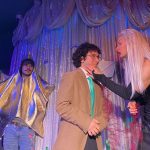The Little Mermaid
A lot of the classic Disney stories that we grew to love as children originate from much darker folk tales. Rapunzels prince was thrown into thorns and blinded, Cinderellas stepsisters cut off their toes and heels to fit into the glass slipperthe list goes on. Hans Christian Andersons original stories were more frightening tales with warnings, rather than happy ever afters. But one story that has always struck me as one that should not have been adapted for children is The Little Mermaid.
The original tale is tragic: the prince never requites ArielÔÇÖs love, and she deals with dark thoughts of murder consequently. The violent themes continue as she literally and metaphorically loses her voice, with Ursula cutting the mermaidÔÇÖs tongue off. While the story is, in its own way, terrifying, it is also rewarding. Ariel learns the value of self-love and sacrifice for the greater good by letting her prince be happy with his bride, teaching the reader helpful truths about self-love and heartbreak. In the Disney tale, all of this is lost, and instead, the common fairy-tale trait of ÔÇÿlove conquers allÔÇÖ prevails. With Ariel essentially giving her most deep and treasured gift up with no reward guaranteed for a prince she did not know is a confusing message to say the least. Within the animated version, the whole essence of AndersonÔÇÖs work is lost and reworked to give the exact message he did not want to portray. Having read both versions as a child, while the original is evidently less ÔÇÿchild friendlyÔÇÖ due to its spooky nature, in todayÔÇÖs more progressive society, it can be argued that the adapted fairy-tale also needs to be reconsidered. With Disney+ÔÇÖs new remake anticipated, it will be interesting to see whether they finally get the correct mix of the heartbreakingly beautiful original story with its poignant lessons, and the ÔÇÿchildrenÔÇÖsÔÇÖ love story our childhood selves adored so much.
By Sofia Mallia
The Witches ÔÇô Roald Dahl
ÔÇ£But this is not a fairy-tale. This is about REAL WITCHESÔÇØ
Throughout my childhood, only one book truly terrified me. It, however, remains in a special place in my heart, even from a young age. Dahl weaves this nightmare tale to truly scare his readers, not only with the witches themselves, but as readers, we are desperate to know more about the terrifying beldams. Our narrator is never named: at 7 years old he lost both of his parents in a horrific car accident and moved in with his grandparents ÔÇô only to be hunted down by witches. The themes youÔÇÖd find here reflect more an adult horror novel: the reader is subject to disfigurement, being hunted and the suffering of grief at such a young age. However, the spine-chilling fear you feel is saved by DahlÔÇÖs writing:
ÔÇ£It doesnÔÇÖt matter who you are or what you look like so long as somebody loves you.ÔÇØ
Roald Dahl remains to have a complicated legacy, however, reading this as a child, I was entranced by the story; IÔÇÖll always be seven years old running away from a gaggle of witches. None of DahlÔÇÖs other books quite reach this level of spine-chilling terror. It is a book best paired with the movie adaptation from the 90s ÔÇô there is no fear quite like the transformation scene where the witches become their true haggard selves.
ÔÇ£Children are foul and filthy!ÔÇØ
Through DahlÔÇÖs writing, I donÔÇÖt think IÔÇÖve felt fear like the moment the children in the story started being transformed into rats. I ran crying to my older sister about being turned into a rat only to have her shout in my face, ÔÇ£IÔÇÖm going to count to three, and IÔÇÖll have a new pet rat!ÔÇØ. I screamed, once again running but in the opposite direction this time. Reading this during this season is a requirement: DahlÔÇÖs comic writing, paired with its darker tones leaves much to be desired, making it the perfect autumn read.
By Cai Jones
Jacqueline WilsonÔÇÖs Novels
Jacqueline Wilson was, undoubtedly, one of the shining stars that lit the pathway into my obsession with literature and writing as a child. She was, in my little seven-year-old eyes, an outright genius in every sense of the word, making me hang onto her every clause and finish each novel within a few hours of purchasing it.
However, as well as inspiring my childhood, fuelling my aspirations and informing me on topics that otherwise I wouldnt have had a clue about, Wilson was also talented. Almost too much. Looking back, her entire bibliography (which, as of last year, was made up of over 100 novels) held darker, more controversial topics  The Illustrated Mum dealt with bipolar disorder and alcoholism, Vicky Angel the process of grieving a lost loved one, and My Sister Jodie bullying, self-harm, borderline paedophilia, teenage pregnancy, suicide  but these seemed, to me, reasonable topics that children should know about. Now, I am not so sure.
So, when I heard that Wilson was actually writing a book directed at an older audience, I breathed a sigh of relief. In my opinion, the magic of her work was the way in which she was able to portray anyoneÔÇÖs story, regardless of background. The level of skill and potential that she held seemed stunted when writing for children (and if she held back in My Sister Jodie, then I cannot even imagine what Baby Love is like), even ÔÇÿemotionally matureÔÇÖ kids like me. I think that, had I not have read WilsonÔÇÖs novels at such a young age, perhaps IÔÇÖd not have grasped the world around me quite as vividly growing up. This could be a positive, or negative, depending on how you view it.
To this day, I find WilsonÔÇÖs work incredible. So, was her fiction aimed at the wrong target audience? Possibly. Did she do an amazing job regardless? Definitely.
By Tegan Davies




